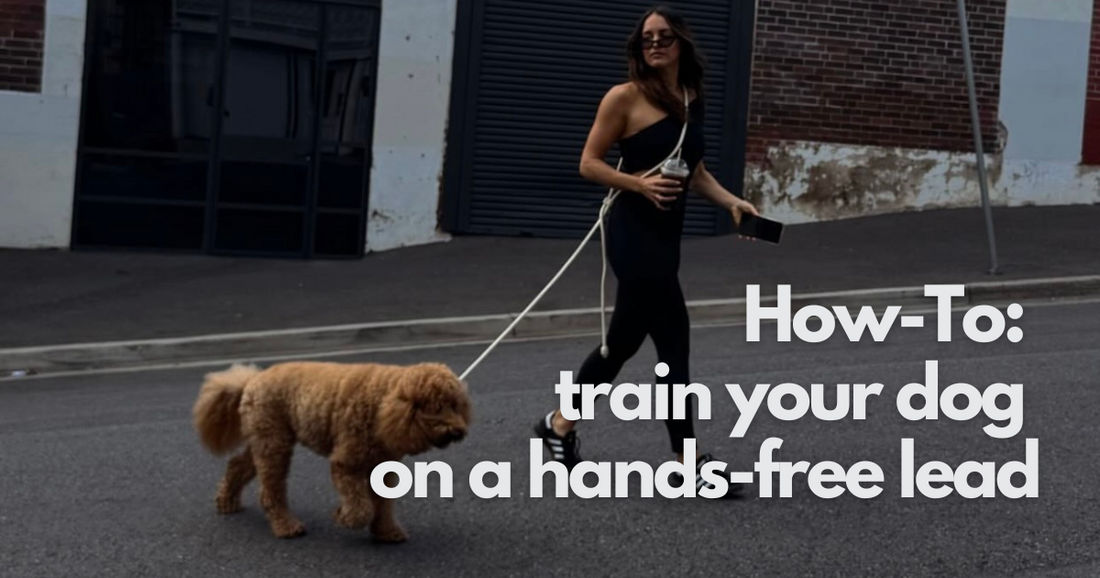
For any dog parent, training your dog is a journey that will require patience, consistency, and the right tools!
One such tool, gaining popularity among dog owners, is a hands-free leash. And it's our most popular product, by far.
This innovative accessory allows for a more interactive and convenient approach to walking your fluffy bestie. In the fast-paced world, we’re busy. We get it. That’s why a hands-free leash can be SO handy when taking your dog out and about. Leaving your hands free for everything else life throws at you.
BUT, if you’re concerned that your dog isn’t quite there yet with their obedience on a leash, specifically heeling, then this guide is for you.
In this article, we'll explore how to effectively use a hands-free leash to train your pooch and strengthen your bond on walks, leaving your hands-free for, well, everything else!

Understanding the Hands-Free Leash:
A hands-free leash, also known as a cross-body or waist leash, is a dog lead system that attaches around the owner's waist, leaving their hands free to perform other tasks while still maintaining control over their dog.
The ST ARGO hands-free leash is made from super durable rope, specifically manufactured with a slight bounce and the right amount of softness so as to be comfortable when worn in close contact with skin.
The Benefits of Using a Hands-Free Leash for Training:
- Improved Communication: With your hands-free, you can use body language more effectively to communicate with your dog, enhancing your training sessions.
- Convenience: Whether you're jogging, hiking, or simply running errands, a hands-free leash allows you to multitask while still keeping your dog close.
- Hands-Free Control: In situations where you need both hands free, such as carrying groceries, picking up your coffee order or pushing a pram, the leash remains securely attached to your waist or across your body, providing continuous control over your dog.
- Bonding Experience: Training with a hands-free leash fosters a stronger bond between you and your dog as you navigate various activities, together.

Training Techniques with a Hands-Free Leash:
It’s important to remember that the hands-free leash, when worn cross-body or around your waist does not have the same level of control as a hand-held leash. So you’ll want to make sure your dog is properly trained to heel, so you can use the leash effectively.
The good news is, you can train your dog on a hands-free leash USING a hands free leash, because of course whilst training, the leash can also be used hand-held.
Our expert tips for training your dog to heel:
Start Slow
Introduce your dog to the hands-free leash gradually. Begin by letting them wear the leash around the house without attaching it to your waist or across your body. This helps them get accustomed to the feel of the leash before incorporating it into outdoor activities.
Minimise Distractions
Training your dog on their new leash around the house also means there are fewer distractions as there would be if you started outside. No kids running around, no other dogs or any distractions that could slow down the training process.
Focus on Basic Commands
Utilise the hands-free leash to reinforce basic commands such as sit, stay, heel, and come. With your hands-free, you can use gestures and body language to accompany verbal cues, making the training more effective.
Use Positive Reinforcement
Reward your dog with treats, praise, or playtime when they respond correctly to commands. Positive reinforcement encourages good behaviour and strengthens the bond between you and your furry companion.
🔥 Pro Tip: Our silicone treat pouch attaches easily to the hands-free leash, ensuring you’ve always got treats on hand for bestie
Practice Consistently
Consistency is key to successful training. Dedicate regular sessions to practise with the hands-free leash, reinforcing desired behaviours and correcting any mistakes gently, but firmly.
Incorporate Distractions
Gradually introduce distractions during training sessions to challenge your dog's focus and obedience. Start with mild distractions and gradually increase the difficulty as your dog progresses.
Be Patient
Remember that training takes time and patience. Avoid becoming frustrated if progress is slow, and always celebrate small victories along the way.

The cream hands-free leash, worn around the waist.
Safety Tips for Using a Hands-Free Leash:
- Choose the Right Size: Ensure the hands-free leash fits securely around your waist without being too tight or too loose. This prevents the risk of it slipping off during walks or activities.
- Monitor Your Dog's Behaviour: Stay alert to your dog's body language and behaviour while using the hands-free leash. Be prepared to adjust your approach if you notice signs of discomfort or anxiety.
- Practice in Safe Environments: Start training in familiar surroundings with minimal distractions before venturing into busier areas. This allows your dog to acclimate to the hands-free leash in a controlled environment.
- Maintain Control: Always maintain control over your dog, especially in potentially risky situations such as near traffic or other animals. Use the leash to guide and redirect your dog as needed to ensure their safety.
Training your dog with a hands-free leash offers a unique opportunity to strengthen your bond while teaching essential obedience skills.
By following the techniques outlined in this guide and prioritising safety, you can enjoy the convenience and effectiveness of hands-free training sessions with your beloved canine companion.
Ready to start training your dog to go hands-free? Check out whether a hands-free lead is the right fit for you.

